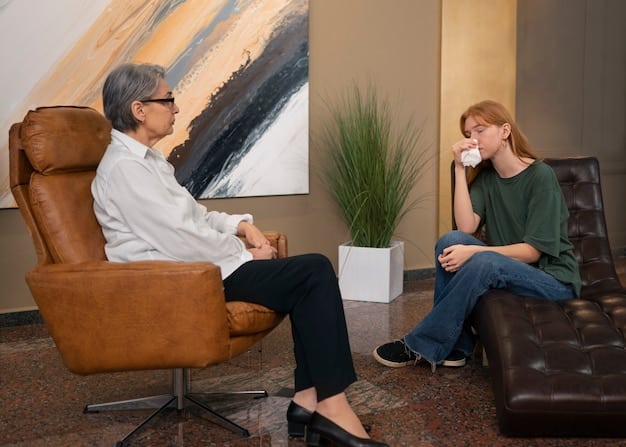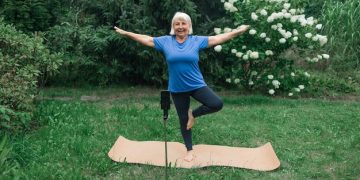Combat SAD: Effective Strategies for Winter Blues

Seasonal Affective Disorder (SAD) is a type of depression linked to seasonal changes, impacting mood, energy, and daily life, yet proactive strategies like light therapy, lifestyle adjustments, and professional support can significantly alleviate symptoms.
As the days grow shorter and the chill settles in, many of us notice a shift in our mood, energy, and overall well-being. While a little dip in spirits is common during winter, for some, this seasonal change triggers a more profound and persistent challenge: Seasonal Affective Disorder (SAD). Understanding how to effectively Combat Seasonal Affective Disorder (SAD): Effective Strategies for Beating the Winter Blues is crucial for maintaining mental wellness throughout the colder months.
Understanding Seasonal Affective Disorder (SAD)
Seasonal Affective Disorder, commonly known as SAD, is a type of depression that recurs with specific seasons, most commonly appearing in late fall or early winter and remitting during spring and summer. While some individuals experience SAD in summer, the winter pattern is far more prevalent, affecting millions. It’s more than just “winter blues” or feeling a bit down due to cold weather; SAD is a clinical condition characterized by depressive symptoms significant enough to impact daily functioning.
The exact causes of SAD are not fully understood, but research suggests a complex interplay of factors contributes to its onset. One primary theory revolves around the reduction in natural sunlight during shorter winter days. This decrease in light can disrupt the body’s internal clock (circadian rhythm), leading to symptoms. Additionally, it can significantly impact serotonin levels, a brain chemical that affects mood, and melatonin production, a hormone that influences sleep patterns and mood. When melatonin levels increase and serotonin levels drop, it can lead to feelings of lethargy, sadness, and an overall lack of motivation. Genetics, age, and pre-existing mental health conditions may also play a role in an individual’s susceptibility to SAD.
The Impact of Reduced Sunlight on Mood
Sunlight is a critical environmental cue for our bodies. It helps regulate our sleep-wake cycle and triggers the production of various neurotransmitters essential for mood regulation. When sunlight diminishes, particularly in regions with long, dark winters, this natural regulation can go awry. Our brains may produce more melatonin, making us feel more sleepy and less energetic, while serotonin levels might decrease, contributing to feelings of sadness and despondency. This imbalance can manifest in a variety of symptoms, making everyday tasks feel overwhelming.
The impact extends beyond just mood. Reduced sunlight can affect our energy levels, sleep patterns, and even our appetite, leading to weight gain in some cases. The cyclical nature of SAD means that symptoms often abate as spring arrives and daylight hours lengthen, but they typically return with the onset of colder, darker seasons. Recognizing this pattern is essential for early intervention and effective management.
- Circadian Rhythm Disruption: Less light throws off our internal clock.
- Serotonin Imbalance: Reduced sunlight can lower mood-boosting serotonin.
- Melatonin Overproduction: Increased darkness leads to more sleep-inducing melatonin.
Understanding these underlying mechanisms helps underscore why many of the strategies for combating SAD focus on light exposure and lifestyle adjustments aimed at rebalancing these natural processes. The goal is to mitigate the depressive symptoms by addressing the physiological changes triggered by the seasonal shift.
Harnessing the Power of Light Therapy
Light therapy, also known as phototherapy, is one of the most effective and widely recommended treatments for Seasonal Affective Disorder. The principle behind it is simple: exposure to bright artificial light mimics natural outdoor light, helping to reset the body’s circadian rhythm and influence brain chemistry. This in turn can improve mood and energy levels, counteracting the effects of reduced natural light during winter months.
A light therapy box typically emits a full-spectrum light, usually 10,000 lux, which is significantly brighter than regular indoor lighting. The recommended usage involves sitting in front of the light box for about 20-30 minutes each morning, ideally shortly after waking up. Consistency is key; daily use throughout the winter can provide substantial benefits. While the initial investment in a quality light box might seem considerable, the long-term benefits for mental well-being often outweigh the cost.
Choosing the Right Light Therapy Box
Not all light boxes are created equal, and choosing the right one is paramount for safety and effectiveness. It’s important to look for light therapy boxes specifically designed for SAD treatment, which typically emit 10,000 lux of light and filter out harmful UV rays. Some models offer adjustable brightness settings, timers, and different viewing angles, providing more flexibility and comfort during use. Consulting with a healthcare professional before starting light therapy is always advised, especially if you have existing eye conditions or are taking medications that increase light sensitivity.
Proper positioning and distance from the light box are also crucial. Typically, the box should be placed at an arm’s length, off to the side, to allow the light to enter your eyes indirectly. Direct staring into the light is not necessary and can be uncomfortable. Many individuals find that integrating light therapy into their morning routine, perhaps while having breakfast or reading, makes it easier to maintain consistency. The goal is to make it a seamless part of your daily life, much like brushing your teeth.
- 10,000 Lux Intensity: Ensure the box provides adequate light.
- UV-Filtered: Protect your eyes from harmful UV radiation.
- Morning Use: Best results are often seen with early morning sessions.
The benefits of light therapy can often be seen within a few days to a couple of weeks of consistent use. It’s a non-invasive treatment with relatively few side effects, making it an attractive option for many individuals struggling with SAD. While it may not cure SAD entirely, it can significantly alleviate symptoms and restore a sense of normalcy during the darker months.

Lifestyle Adjustments for SAD Management
Beyond light therapy, several impactful lifestyle adjustments can play a significant role in managing and mitigating the symptoms of Seasonal Affective Disorder. These strategies focus on holistic well-being, recognizing that physical health, social connections, and daily routines are intricately linked to mental health. Incorporating these practices can create a resilient foundation against the winter blues.
Firstly, prioritizing regular physical activity is crucial. Exercise is a powerful natural antidepressant, releasing endorphins that boost mood and reduce stress. Even a brisk walk outdoors, especially during daylight hours, can make a difference. The combination of physical movement and exposure to what little natural light is available can have a synergistic positive effect. Aim for at least 30 minutes of moderate-intensity exercise most days of the week.
The Role of Diet and Nutrition
What we eat profoundly impacts how we feel. During winter, there’s often a temptation to gravitate towards comfort foods high in sugar and unhealthy fats, which can lead to energy crashes and exacerbate feelings of sluggishness. Instead, focus on a balanced diet rich in whole foods. Foods high in omega-3 fatty acids (like fatty fish, flaxseeds, and walnuts), vitamin D (found in fortified foods, fish, and some dairy), and complex carbohydrates can support brain health and mood stability. Hydration is also often overlooked but essential for overall functioning.
Consider nutritional supplements under the guidance of a healthcare professional. Vitamin D deficiency is common, particularly in winter, and supplementation can be beneficial for those with SAD. Some individuals also find relief with omega-3 supplements or herbal remedies like St. John’s Wort, though these should always be discussed with a doctor due to potential interactions with other medications.
Maximizing Natural Light Exposure Indoors
Even without a light therapy box, maximizing natural light exposure within your home and workplace can be surprisingly effective. Open blinds and curtains immediately upon waking to let in whatever sunlight is available. Arrange furniture to sit closer to windows. Consider painting rooms in lighter colors to reflect more light, and keep spaces uncluttered to allow light to flow freely. Spending time near windows in sunny rooms can subtly improve your mood and energy levels throughout the day.
- Regular Exercise: Boost mood and energy naturally.
- Balanced Diet: Fuel your body with mood-supporting nutrients.
- Embrace Nature: Spend time outdoors, even on cloudy days.
These lifestyle adjustments, when consistently applied, can significantly enhance your resilience against SAD. They empower you to take active steps in managing your well-being, providing a sense of control over a condition that can often feel overwhelming.
The Importance of Social Connection and Routine
In the challenging grip of Seasonal Affective Disorder, the inclination to withdraw and isolate oneself can be strong. However, fostering social connections and maintaining a structured daily routine are two powerful antidotes to the isolating and disorienting effects of SAD. These elements provide a sense of purpose, accountability, and emotional support that are vital for mental well-being.
Engaging with others, whether friends, family, or support groups, can counteract feelings of loneliness and provide opportunities for sharing experiences and perspectives. Even during colder months, planning social activities indoors or virtually can make a significant difference. Simple acts like a phone call, a video chat, or a planned coffee date can break the cycle of isolation. Remember, mental health is often supported by social health, and staying connected can provide a much-needed emotional lift.
Establishing a Consistent Daily Schedule
A consistent daily routine, especially one that includes regular sleep patterns, mealtimes, and activities, can stabilize your circadian rhythm and provide a comforting sense of predictability during the unpredictable changes of the seasons. Aim to go to bed and wake up at roughly the same time each day, even on weekends. This consistent sleep-wake cycle helps regulate melatonin and serotonin production, which in turn can reduce SAD symptoms.
Beyond sleep, schedule specific times for work, leisure, exercise, and social interaction. Having a structure to your day can combat the lethargy and lack of motivation often associated with SAD. It also helps in ensuring you are incorporating other beneficial strategies, like light therapy or outdoor walks, into your daily life rather than letting them fall by the wayside.
- Active Social Engagement: Combat isolation with planned interactions.
- Consistent Sleep Schedule: Regulate your natural body clock.
- Structured Daily Activities: Maintain a sense of purpose and routine.
By intentionally prioritizing social connections and adhering to a well-structured routine, individuals can build a robust defense against the onset and severity of SAD symptoms. These strategies not only offer direct therapeutic benefits but also empower individuals to actively participate in their own recovery and well-being.
Professional Support and Treatment Options
While lifestyle adjustments and light therapy are highly effective for many individuals combating Seasonal Affective Disorder, there are instances where professional support becomes essential. Recognizing when to seek help and understanding the available treatment options are crucial steps in managing more severe or persistent symptoms of SAD.
A healthcare professional, such as a general practitioner, psychiatrist, or therapist, can provide a comprehensive diagnosis, rule out other conditions that might mimic SAD, and recommend a tailored treatment plan. This plan might involve a combination of therapies, medication, or specific recommendations based on your individual circumstances and the severity of your symptoms. Self-diagnosis and self-treatment can delay effective intervention, so it’s always advisable to consult an expert.
When to Consider Medication for SAD
Antidepressant medications, particularly selective serotonin reuptake inhibitors (SSRIs), are often prescribed for SAD, especially if symptoms are severe or if other treatments haven’t been sufficiently effective. SSRIs work by increasing the levels of serotonin in the brain, helping to improve mood. While medication can offer significant relief, it’s typically considered in conjunction with other therapies and under strict medical supervision. It’s important to discuss the potential benefits, side effects, and duration of treatment with your doctor.
For some, starting medication before the typical onset of winter symptoms can be a proactive measure to prevent or lessen the severity of SAD episodes. This preventive approach should be carefully planned with a healthcare provider. The decision to use medication is highly personal and should be based on a thorough assessment of your symptoms, medical history, and personal preferences.
The Benefits of Psychotherapy
Psychotherapy, particularly cognitive-behavioral therapy (CBT), has proven to be an effective treatment for SAD. CBT helps individuals identify and change negative thought patterns and behaviors associated with the disorder. It can equip you with coping strategies to manage symptoms, improve problem-solving skills, and develop more positive ways of thinking about challenging situations. A therapist can also help you anticipate seasonal changes and implement preventive strategies proactively, reducing the impact of SAD before it fully takes hold.
- Consult a Professional: Seek diagnosis and personalized treatment plans.
- Medication Consideration: Discuss SSRIs with a doctor if symptoms are severe.
- Cognitive-Behavioral Therapy: Learn coping strategies and manage negative thoughts.
Combining professional support with self-management strategies often yields the best outcomes for individuals struggling with SAD. It emphasizes a holistic approach to mental health, ensuring all facets of an individual’s well-being are addressed comprehensively.

Proactive Planning and Preventive Measures
One of the most effective ways to combat Seasonal Affective Disorder is to adopt a proactive stance, implementing preventive measures before the onset of winter symptoms. Thinking ahead and preparing your mind and body for the seasonal shift can significantly lessen the impact of SAD, transforming winter from a period of dread into one of manageable transition.
Begin by scheduling your light therapy sessions or increasing outdoor light exposure as daylight hours start to noticeably shorten, typically in late fall. Don’t wait for symptoms to emerge; start your preventative measures early. For those with a history of SAD, this anticipatory action can be a game-changer, helping to regulate biological rhythms before they become disrupted.
Creating a Cozy and Stimulating Environment
Your living and working spaces can greatly influence your mood. During winter, focus on creating environments that feel cozy, warm, and inviting. This might involve strategic lighting choices—using warmer light bulbs, adding lamps to brighten dark corners, or even investing in smart lighting systems that mimic natural light changes. Introduce elements that evoke warmth and comfort, such as soft blankets, engaging books, or calming scents like aromatherapy diffusers.
Furthermore, ensure your indoor spaces remain stimulating and engaging. Engage in hobbies, pursue creative outlets, or simply arrange your space to be conducive to relaxation and well-being. A stimulating environment can help keep your mind active and positive, providing a welcome distraction from the often dull and dreary outdoor conditions.
Building a Support Network
Beyond individual actions, cultivating a robust support network is a critical preventive measure. This network can include trusted friends, family members, or even a SAD-specific support group. These individuals can provide emotional support, practical assistance, and understanding during challenging times. Knowing you have people to lean on can reduce feelings of isolation and provide an outlet for discussing your experiences. Regular check-ins with your support network can also serve as an early warning system if symptoms begin to escalate.
- Early Intervention: Start light therapy and outdoor activities before symptoms.
- Optimize Your Space: Create a light, warm, and stimulating home environment.
- Nurture Connections: Build a strong support system for emotional well-being.
By integrating these proactive and preventive strategies into your seasonal routine, you can significantly empower yourself to navigate the winter months with greater resilience and a more positive outlook. These measures emphasize foresight and self-care, essential components in effectively combating SAD.
Embracing Mindfulness and Self-Compassion
Navigating Seasonal Affective Disorder requires not only practical strategies but also a deep component of mental fortitude and emotional regulation. Embracing mindfulness and cultivating self-compassion are not just supplementary practices; they are foundational elements that can significantly enhance your ability to cope with the emotional fluctuations that SAD brings. These practices foster a kinder, more aware relationship with your internal experiences, allowing you to acknowledge and process difficult feelings without being overwhelmed by them.
Mindfulness involves bringing focused attention to the present moment, observing thoughts, feelings, and bodily sensations without judgment. For someone experiencing SAD, this can mean gently acknowledging feelings of sadness or lethargy without immediately trying to push them away or criticize oneself for having them. This non-judgmental awareness can reduce the secondary suffering that often comes from struggling against one’s own emotional state. Simple practices like mindful breathing, body scans, or walking meditation can be integrated into your daily routine, even for just a few minutes.
Practicing Self-Care with Intention
Self-compassion, on the other hand, extends kindness and understanding to oneself, especially during moments of perceived failure or suffering. It’s about treating yourself with the same warmth and care you would offer to a dear friend facing a similar challenge. When battling SAD, it’s easy to fall into a cycle of self-blame or frustration over reduced energy levels and diminished motivation. Self-compassion encourages you to recognize that these are symptoms of a condition, not personal failings. It allows for rest when needed and celebrates small victories, rather than dwelling on what hasn’t been accomplished.
Intentional self-care becomes a deliberate act of nurturing your well-being. This might involve setting realistic expectations for yourself during the winter, allowing for more rest, or engaging in activities that genuinely bring you joy and comfort, even if they are simple. It’s about listening to your body and mind and responding with kindness, rather than pushing through with unsustainable demands. Recognizing your limits and respecting them is a profound act of self-care and self-compassion during challenging times.
- Mindful Awareness: Observe feelings without judgment.
- Self-Kindness: Treat yourself with understanding and compassion.
- Acceptance: Acknowledge that difficult feelings are part of the SAD experience.
By consistently practicing mindfulness and self-compassion, you can build emotional resilience, reduce feelings of isolation, and navigate the winter months with greater equanimity. These internal strategies complement external interventions, creating a comprehensive approach to managing Seasonal Affective Disorder.
| Key Strategy | Brief Description |
|---|---|
| 💡 Light Therapy | Daily exposure to bright artificial light can reset your body clock and improve mood. |
| 🏃 Active Lifestyle | Regular exercise and time outdoors can naturally boost mood and energy levels. |
| 🥗 Healthy Nutrition | A balanced diet, rich in essential nutrients, supports brain health and mood stability. |
| 🤝 Seek Support | Connect with friends, family, or professionals for tailored guidance and mental health care. |
Frequently Asked Questions About SAD
▼
SAD is a type of depression that recurs at specific times of the year, most commonly during the fall and winter months. It’s characterized by symptoms like low mood, fatigue, increased appetite, and difficulty concentrating, which improve or disappear during sunnier seasons. It is more than just feeling “blue” in winter; it is a recognized clinical condition that can significantly impact daily functioning.
▼
Light therapy, using a specialized light box that emits bright, full-spectrum light, mimics natural sunlight. This exposure helps regulate the body’s circadian rhythm, boosts serotonin levels, and can suppress melatonin production, all of which are often disrupted in individuals with SAD. Consistent daily use, especially in the mornings, can significantly alleviate depressive symptoms and improve energy.
▼
Absolutely. A healthy diet rich in omega-3s, vitamin D, and complex carbohydrates supports brain health and mood stability. Regular exercise, particularly outdoors during daylight, releases mood-boosting endorphins and provides natural light exposure. These lifestyle changes can complement other treatments, reducing symptom severity and improving overall well-being by fostering physical and mental resilience.
▼
If your SAD symptoms are disrupting your daily life, affecting your relationships, work, or school, or if feelings of hopelessness or thoughts of self-harm emerge, it’s crucial to seek professional help. A healthcare provider can offer an accurate diagnosis, recommend tailored treatments, including light therapy, medication, or psychotherapy, and rule out other underlying conditions. Early intervention can lead to better outcomes.
▼
Yes, proactive measures are highly effective. Start with light therapy sessions in late fall before symptoms fully emerge. Maximize natural light exposure by opening blinds and spending time outdoors. Maintain regular exercise, a balanced diet, and a consistent sleep schedule year-round. Building a strong social support network and practicing mindfulness also contribute significantly to preventing and mitigating SAD’s impact.
Conclusion
Navigating Seasonal Affective Disorder requires a multifaceted and proactive approach. By understanding its nuances and employing a range of effective strategies, from the proven benefits of light therapy to thoughtfully integrated lifestyle adjustments and the crucial role of professional support, you can significantly mitigate its impact. Embracing self-compassion, maintaining social connections, and planning ahead are also vital components in fostering resilience. The journey to combating SAD is an ongoing one, continually adjusting and adapting to the seasonal shifts, ultimately empowering you to reclaim your well-being and thrive throughout the year, even through the darker winter months.





